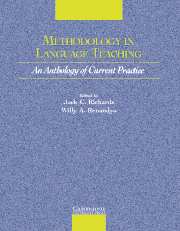Book contents
- Frontmatter
- Contents
- Acknowledgments
- Introduction
- Section I Approaches to Teaching
- Section 2 Lesson Planning and Classroom Management
- Section 3 Classroom Dynamics
- Section 4 Syllabus Design and Instructional Materials
- Section 5 Task and Project Work
- Section 6 Learning Strategies
- Section 7 Teaching Grammar
- Section 8 Teaching Pronunciation
- Section 9 Teaching Speaking
- Section 10 Teaching Listening
- Section 11 Teaching Vocabulary
- Section 12 Teaching Reading
- Section 13 Teaching Writing
- Section 14 Assessment
- Section 15 Technologies in the Classroom
- Section 16 Professional Development
- Chapter 39 The English Teacher as Professional
- Chapter 40 Developing Our Professional Competence: Some Reflections
- Chapter 41 Research in Your Own Classroom
- Credits
- Author Index
- Subject Index
- References
Chapter 39 - The English Teacher as Professional
Published online by Cambridge University Press: 10 November 2010
- Frontmatter
- Contents
- Acknowledgments
- Introduction
- Section I Approaches to Teaching
- Section 2 Lesson Planning and Classroom Management
- Section 3 Classroom Dynamics
- Section 4 Syllabus Design and Instructional Materials
- Section 5 Task and Project Work
- Section 6 Learning Strategies
- Section 7 Teaching Grammar
- Section 8 Teaching Pronunciation
- Section 9 Teaching Speaking
- Section 10 Teaching Listening
- Section 11 Teaching Vocabulary
- Section 12 Teaching Reading
- Section 13 Teaching Writing
- Section 14 Assessment
- Section 15 Technologies in the Classroom
- Section 16 Professional Development
- Chapter 39 The English Teacher as Professional
- Chapter 40 Developing Our Professional Competence: Some Reflections
- Chapter 41 Research in Your Own Classroom
- Credits
- Author Index
- Subject Index
- References
Summary
INTRODUCTION
A ‘professional’ is, broadly speaking, someone whose work involves performing a certain function with some degree of expertise. But a narrower definition limits the term to apply to people such as doctors, teachers and lawyers, whose expertise involves not only skill and knowledge but also the exercise of highly sophisticated judgement, and whose accreditation necessitates extensive study, often university-based, as well as practical experience.
This notion of professionalism can be further clarified by contrasting it with others that it is often set in opposition to: concepts such as lay, amateur, technician, academic. Each contrast offers an understanding from a different perspective.
This article explores these contrasts, and relates them to the work of the English teacher.
PROFESSIONAL VERSUS LAY
A ‘lay’ population is a population that does not belong to a specified professional group. Members of the professional group possess certain skills, knowledge, and conventions that the lay population do not have. Typically, they communicate between themselves employing vocabulary that is not readily comprehensible to a layperson (in our case, examples would be cloze, L1, L2, ESP etc.). These qualifications make them into a ‘club’ for the initiated to which others do not belong: a professional community.
Like many others, the professional community of English teachers has developed means of consolidating relationships between its members and created opportunities for them to benefit from each other's knowledge. It holds courses and conferences: locally or nationally and, increasingly, internationally (IATEFL, TESOL etc.).
- Type
- Chapter
- Information
- Methodology in Language TeachingAn Anthology of Current Practice, pp. 388 - 392Publisher: Cambridge University PressPrint publication year: 2002
References
- 9
- Cited by

